In Mali, the environment is not your friend.
That is true for many people in this West African nation, which encompasses vast swaths of the brutally hot Sahara desert and semi-arid Sahel region. But it is especially true if your task is to operate aircraft on complex missions at a moment’s notice.
First there is the heat, which is relentless and suffocating. Temperatures of 45 C (113 F) or higher are routine, taxing aircraft performance and pushing avionics to their operating limits. The heat is oppressive under any circumstances, but for aircrew going about their duties in full Nomex and body armor, it is infernal. There are special risks for maintainers, as fluids and metal parts can remain near their operating temperatures hours after a flight. According to Royal Canadian Air Force (RCAF) avionics systems technician Cpl James Hope, “Some of us have already gotten burns on aircraft that have been shut down for three or four hours.”
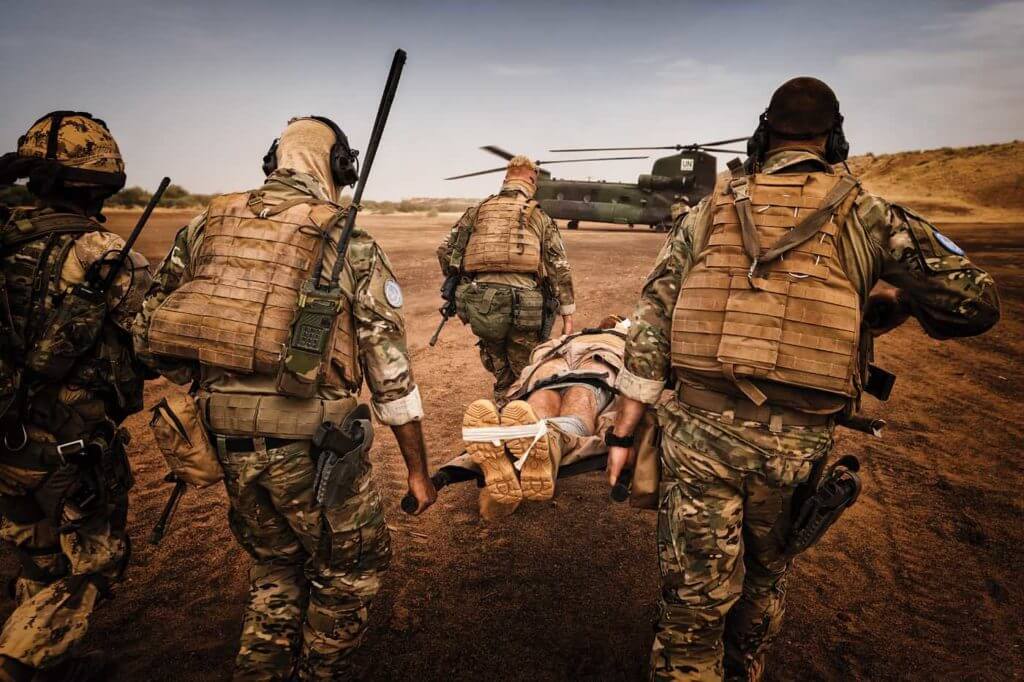
Then there is the dust. Unlike the omnipresent dust in Afghanistan, which tends to be powdery and fine, the dust around Gao is like coarse grit on sandpaper. A Boeing CH-147F Chinook landing off-airport creates an enormous dust cloud that overtakes the helicopter from the rear, first obscuring the visibility of the loadmaster on the ramp, then spitting sand into the cabin before finally boiling up at the nose of the aircraft, turning the view out the cockpit windscreen brown at the most critical phase of flight.
At night, the coarse sand striking the rotor blades creates a visible halo of sparks in a phenomenon that has been dubbed the “Kopp-Etchells effect” (after two soldiers who were killed in Afghanistan in 2009). It is surreally beautiful to witness, but so intense as to be distracting under night vision goggles. The dust chews at aircraft seals and erodes paint off helicopter rotor blades, disrupting their track and balance. On the Chinook, it even grinds down the safety wires on the main rotor blade tips. “If you take a look, you can see the metal is becoming thin and brittle and we have to keep replacing them,” Hope said.
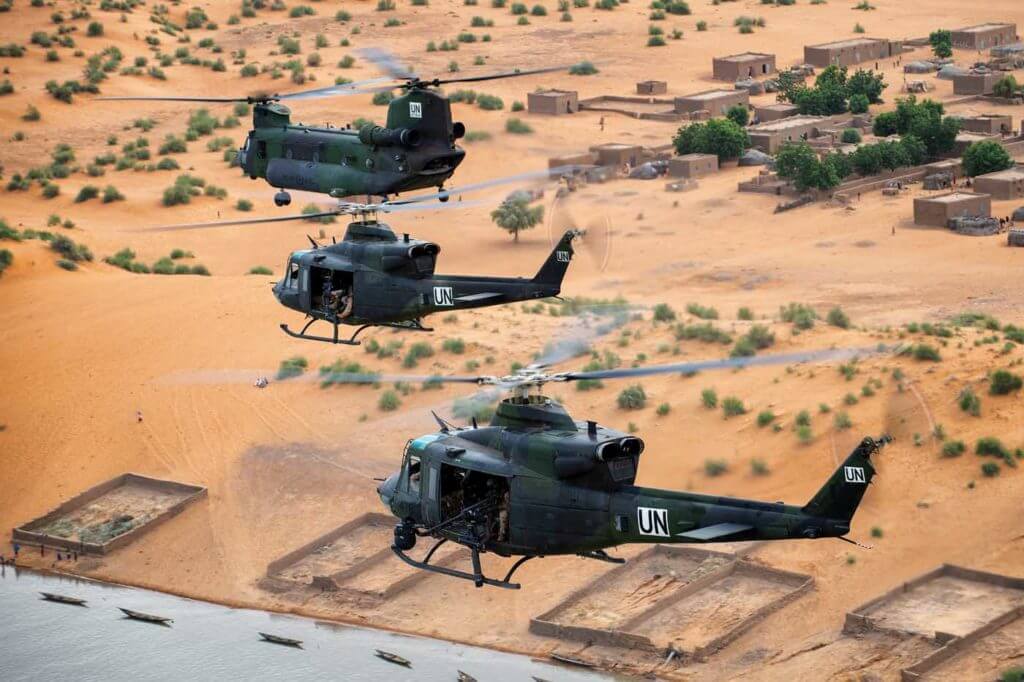
To arrive at these everyday challenges, the RCAF had to overcome an even greater hurdle: standing up a forward aeromedical evacuation capability that is brand-new to Canada, then deploying it nearly 5,000 miles (8,000 kilometers) away, all on less than five months’ notice. Canada announced on March 19, 2018, that it would be sending helicopters to Mali as part of Operation Presence, its first large-scale deployment for the UN in nearly 15 years. By Aug. 1, Task Force Mali had achieved initial operating capability (IOC) in theater. It declared final operating capability — with a total of three CH-147F Chinooks and five Bell CH-146 Griffon helicopters — just two weeks later.
“I’m really proud of our people,” said task force commander Col Chris McKenna when Vertical 911 visited Gao in October. “They didn’t have a lot of time to prepare for this, but I’m always amazed at the Canadian Forces being able to be so adaptable and flexible and jump into a mission set like this with not a lot of warning.”

Developing a capability
The RCAF pulled off something similar a decade ago, when it stood up the Joint Task Force Afghanistan Air Wing to support Canadian soldiers in Kandahar province. When Canada acquired six CH-47D helicopters from the U.S. Army in 2008, it had been 16 years since it had sold its previous Chinooks to the Netherlands — an epoch in organizational terms. Yet the RCAF managed to train a new generation of Chinook pilots and maintainers and deploy to Afghanistan in less than a year, remaining there until the withdrawal of Canadian troops in 2011.
McKenna, then a major, commanded Canada’s Chinooks in Afghanistan. From 2014 to 2016, he served as the commanding officer of 450 Tactical Helicopter Squadron in Petawawa, Ontario, where he helped re-establish the RCAF’s Chinook capabilities using its new fleet of 15 CH-147F models. It took a while, he said, but the RCAF is “now much further ahead than we were in Afghanistan,” particularly with respect to how the Chinooks interact with their escort helicopters, CH-146 Griffons. From a tactical perspective, he said, “I think now what we’ve arrived at after five years of capability development is a much more adaptable and robust package, which allowed us within about a two- or three-month period to adapt it to Mali.”
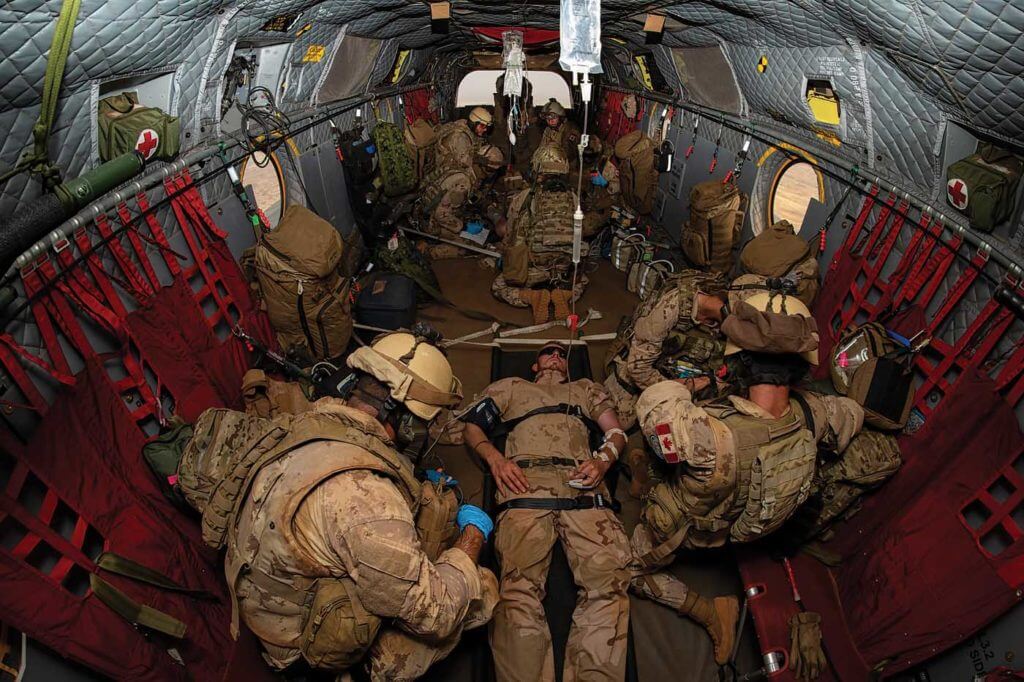
However, one capability that was conspicuously lacking within the RCAF was a dedicated forward air evac capability (in Afghanistan, Canada relied on allies for medevac support). Recognizing this deficiency, the RCAF began laying the groundwork for a forward air evac capability around a year before Canada committed to MINUSMA.
According to McKenna, “we sent our experts all over the world to consult with folks who had done this mission set, to make sure that we were going to adapt best practices.” However, these research and development efforts were largely siloed within aviation, medical, and procurement divisions.
“Without a tasked mission, to invest all of the time, money, and resources into collating them into a cohesive package — that had not occurred at the time of the [March 19] announcement,” he said. “So that was really our focus post-announcement, to take these individual lines of effort that were ongoing and smash them together . . . to be able to come here to do this job safely.”
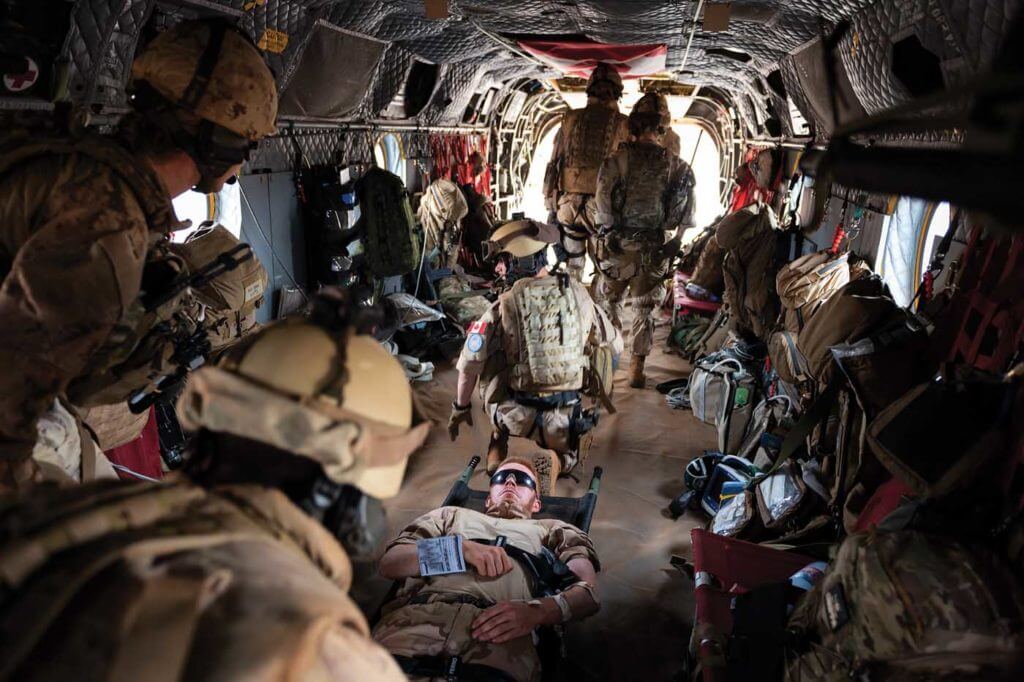
The forward air evac teams operating in Mali comprise not only RCAF flight crews, but also medical personnel from the Royal Canadian Medical Service and Canadian Army soldiers from the Royal 22nd Regiment, or “Van Doos,” who provide a force protection component. A key integration exercise occurred in May, when they all convened in Wainwright, Alberta, to validate forward air evac concepts. “Wainwright was the first time we were all together, and it worked pretty seamlessly right off the bat, which was really great to see,” said Capt Jackie Ruis, a Chinook pilot.
With the concepts proven, the next challenge was to package everything up and transport it to a remote airfield in West Africa. Complicating matters was the fact that the runway in Gao — which also serves the French-led counterterrorism effort Operation Barkhane — was under construction at the time of Canada’s deployment, making it impossible to land large transport planes there until the work was completed. So, instead, the first helicopters were flown via Boeing C-17 (or CC-177 in the RCAF’s designation) to Ouagadougou, Burkina Faso; reassembled; then flown over 250 miles (400 kilometers) into Gao.

When the runway finally reopened, it saw heavy use as the Canadians flew in the thousands of tons of materiel needed to sustain a year-long deployment. The task force established an operational support hub over 1,100 miles (1,800 kilometers) away in Dakar, Senegal, where it based a CC-130J Hercules that still flies regular sustainment missions. But for the initial push, it also used the CC-177 and a contracted Antonov An-225 (for flights from Trenton, Ontario, to Dakar) and Ilyushin Il-76 (from Dakar to Gao).
“Some days we had an Il-76, a C-17, and a Herc all landing within an hour of each other,” recalled McKenna, pointing out that simply handling so much materiel is a daunting task in itself. As task force commander, the biggest problem he had was determining how to prioritize loads in order to meet the deadline for IOC. “Thankfully our Herc teams in Dakar were unbelievably flexible. They were able to re-prioritize loads within hours for us, to ensure that the next gateway was going to be met. . . . And we were able to get it all done,” he said.
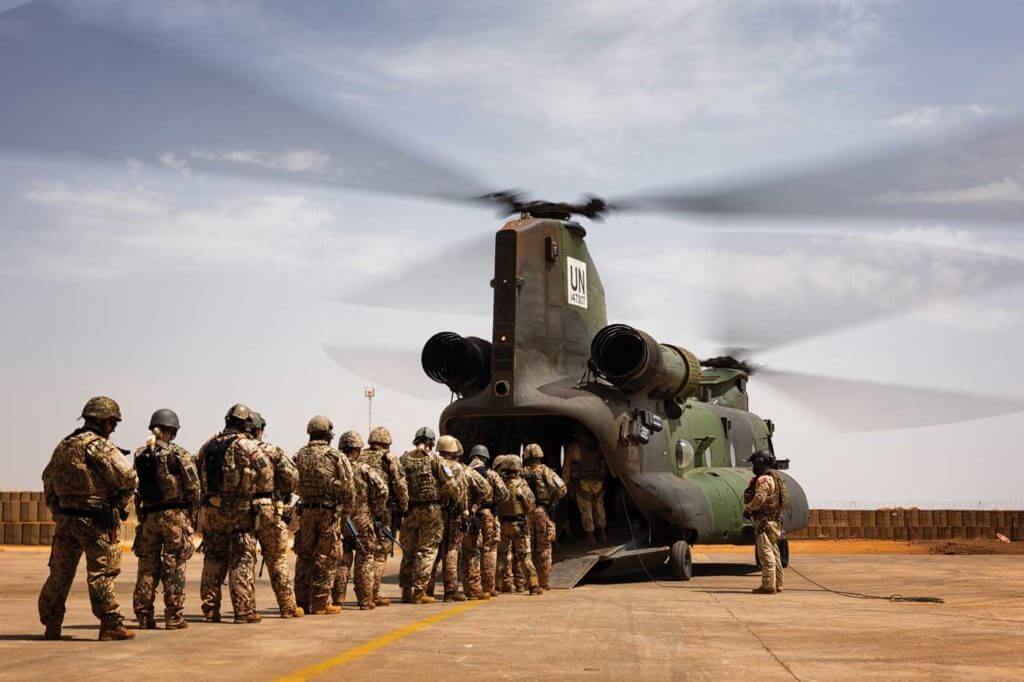
A flying trauma bay
Canada hasn’t skimped on the service it’s providing to the UN, neither from an aviation perspective, nor a medical one. Its forward air evac program, called the Canadian Medical Emergency Response Team (CMERT), is based on the British MERT model, and like that model takes full advantage of the Chinook’s spacious cabin to deliver a sophisticated medical capability.
“CMERT aims to bring essentially a resuscitation room right to the point of injury,” explained Maj Andrew McLaren, a medical specialist who in October was leading one of three four-person medical teams, each composed of a critical care physician or anesthesiologist, a critical care nurse, and two medical technicians. “We load multiple patients in and we treat it like a trauma bay in a hospital, where we can take all of the technology that we would in a hospital, but moving rapidly towards, say, a surgeon, which is what a patient needs.”
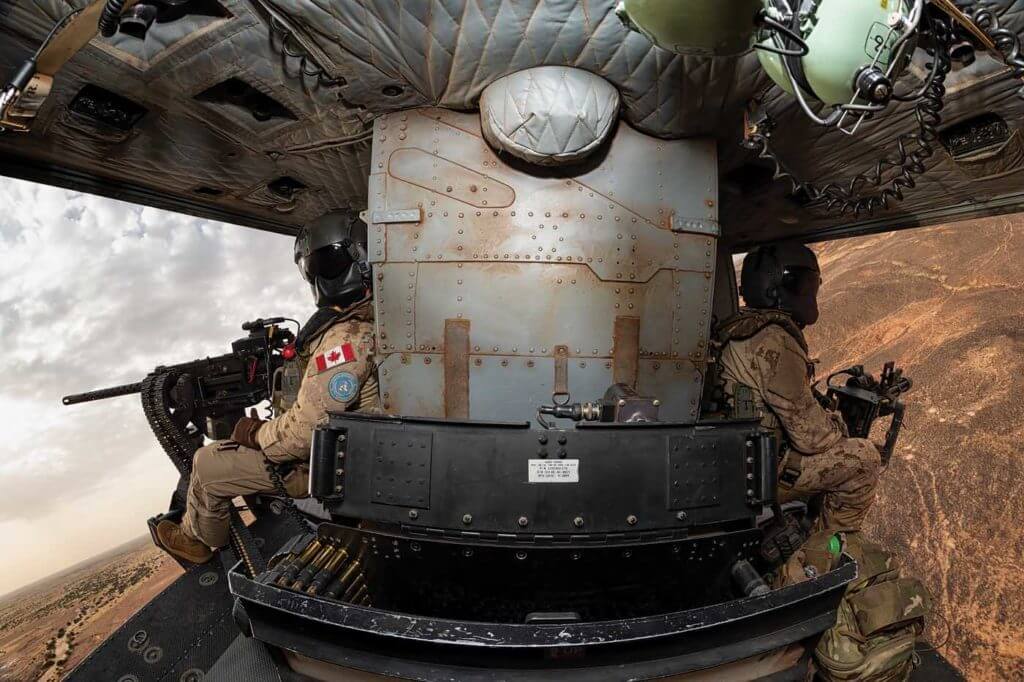
Of course, it’s not exactly like a trauma bay in a hospital. For one thing, it’s hotter. “Just operating in temperatures of 40 or 50 degrees [C] in the back here, with 50 to 60 pounds of armor on, it can be very restrictive,” McLaren continued. “Operating as a resus team at home is difficult at times already, but now we have the body weight, and weird body positions, and we’re on our knees, and we’re in 50 degrees of heat, and we’re tethered to a moving platform. And so all of that is stuff that is not taught in medical school, or taught at hospitals at home.”
The four core medical personnel — already a large team for a helicopter — are further supplemented by four force protection soldiers with basic medical training. These soldiers ride near the ramp of the Chinook, and are the first to egress on a scene call, clearing the way for the medics. However, after the aircraft lifts with a patient, “we incorporate them into the team, so now we’re a team of eight, and that allows us to more thoroughly apply the technology and treat more patients,” McLaren said.

Meanwhile, the Chinook is always escorted on medevac missions by two armed CH-146 Griffons, one of which serves as an on-scene commander while the other scans for external threats. According to McKenna, that differs from the approach taken by the Germans who previously provided forward air evac to MINUSMA using NHIndustries NH90s, and who used Airbus Tiger escort helicopters only as threat conditions warranted.
“Our view was that we always wanted our Griffons, and that medevac package is a coherent package of Chinook and Griffon,” McKenna said. “To be able to do this safely, we assess having that Griffon there as an on-scene commander, as a top cover, as a potential to provide fire and provide illumination. . . . So that’s very Canadian, and we were able to get that all put together and exercised in a short amount of time.”

By late January, nearly six months into its deployment, Task Force Mali had performed six medevac missions, transporting a total of 21 patients. The Canadian teams had also conducted many realistic training missions, in cooperation with ground forces from partner nations. These regular exercises simulate the real thing as closely as possible, from the initial scramble of the crews, to the transfer of volunteer “patients” into waiting ambulances back at the airfield. And they have paid off, according to Ruis, who was a pilot on one of Canada’s first actual medevacs.
“Our training has been so good, it just felt like I was going on another flight,” she said. “It’s a really good feeling knowing that if someone needs us, we’re here to help.”

Pride in the mission
While the tempo of medevac operations in Mali is relatively low compared to theaters like Afghanistan, the Canadians’ mere presence is a mission enabler for partner nations like Germany, which contributes ongoing intelligence support to MINUSMA.
A German officer responsible for force protection, who wished to be identified only as David N. for security reasons, explained that German troops rarely venture farther from camp than a distance that would allow them to return a critical trauma patient during the so-called “golden hour.”

During the month-long gap between the cessation of Germany’s forward air evac operations, and the start of Canada’s, this distance shrank to just 30 miles (50 kilometers) in a rainy season that turned dirt roads into muddy obstacle courses. With the Canadian capability now up and running, “we are basically able to operate in a circle of around 200 kilometers,” he said. “Without the helicopters, without forward air capability, we cannot fulfill our mission.”
Canada is also using its spare capacity to support MINUSMA with tactical airlift operations, including the insertion and extraction of troops and their gear. In September, for example, the task force used its Chinooks to transport German soldiers to a populated island in the wide, braided Niger River. According to David N., the island had not been visited by UN forces in more than three years, and “the capacity of these helicopters gave us the [ability] to stay there overnight” while conducting intelligence missions.
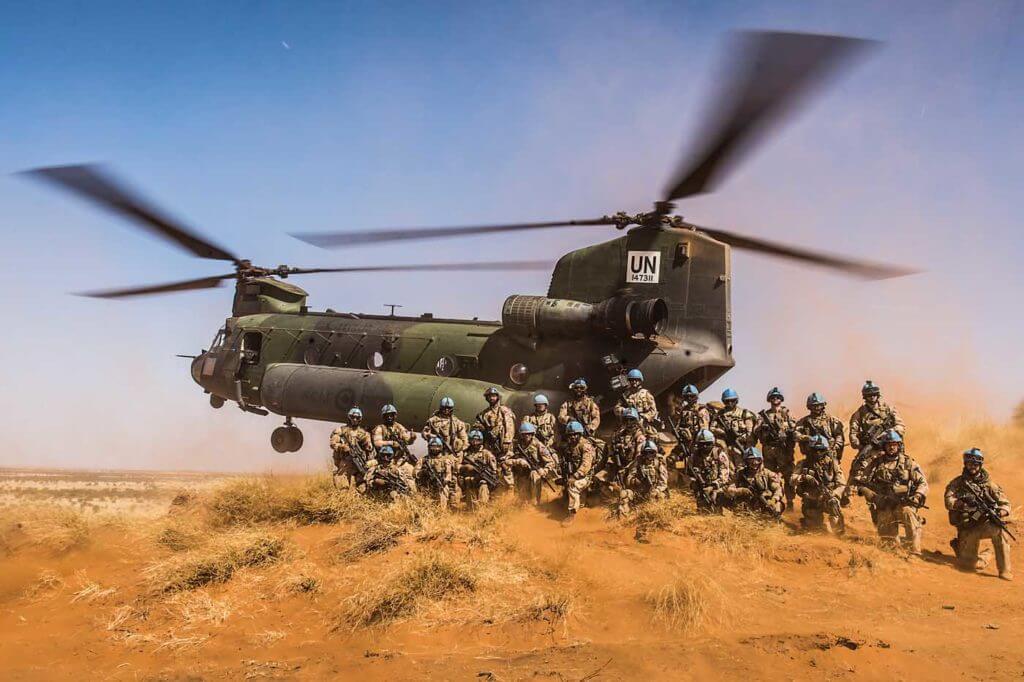
Sgt Maj Sebastian Hoek, a Dutch officer who works with the task force to coordinate tactical airlifts for the Netherlands’ Long Range Reconnaissance Patrol (LRRP) Task Group in Mali, praised the Canadians not only for their capabilities, but also for their “can-do mentality.”
“They’re here to fly, and in everything they do, they show it,” he said. “When they see something come up that could be a snag, they think with us, how could we work around this so everything is in order and the mission can go ahead?”
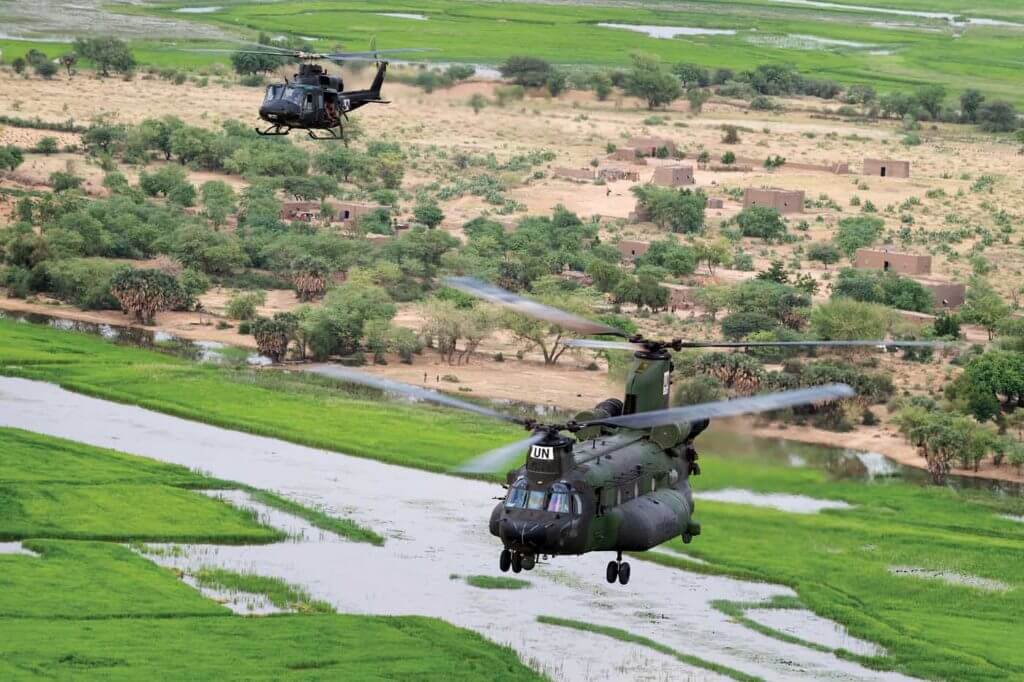
McKenna suggested that the development of a forward aeromedical evacuation capability and the skills being honed during this deployment will have lasting benefits for Canada, both at home and abroad. “As we return to Canada, we have a capability here that we can apply to many other theaters, or even domestically in a disaster,” he said. “I think this is just another really good tool in the toolbox for tac aviation in Canada and the RCAF.”
In the meantime, he said, Canada’s advanced CH-147F Chinooks and capable flight and medical crews are making a real contribution to an expansive, under-
resourced theater that’s badly in need of their services. El Salvador is supporting MINUSMA with six armed MD 500E helicopters, but there are no other helicopters currently assigned to the UN mission — for an area of operations that is many times the size of Kandahar province.

“I think Canada is providing something here that’s really tangible for the force, and hopefully is being seen as very relevant and helpful,” he said. “There’s a lot of pride in having such an important mission set and being relied upon by so many, and there’s a lot of pride I think in wearing the blue beret here, and being able to help our partners in West Africa.”






Considering the hot environment and ongoing physical threat I am very proud of our our Canadian contribution operating in this hostile theatre